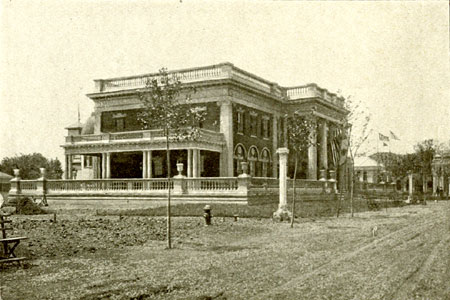
The New England Building represented the
states of Maine, New Hampshire, Vermont, Massachusetts, Connecticut and
Rhode Island. It was designed by a female architect from Boston, Josephine
Wright Chapman, who visited the Buffalo site on February 15, 1901 to
arrange the construction details. The design requirement imposed upon her
by the New England commissioners was that it was to resemble no building
ever built. Completed in early June for $20,000, the Colonial style building
had its grand opening on June 17 when the Daughters of the American Revolution
celebrated Bunker Hill Day. It was lighted by electricity.
The exterior of the building was constructed
of staff painted to resemble red brick with white marble trimmings. It was
surrounded by lawn intersected with garden paths.

|
As described in two articles in the Buffalo
Evening News, "The entrance, facing northward, is a large Colonial
hall which divides at the landing and leads to a gallery supported by an
arcade. To the left of the front door is a large room arranged as a bureau
office of information and registration, with postoffice, telephone booths,
and toilet conveniences. In the rear are the custodian's quarters and the
building committee's room. To the right are a reception and writing room,
with windows extending to the floor. Convenient to the rear room are storeroom,
coatroom and smoking room. A wide staircase branches off from the hall,
leading to a corridor on the second floor. The second floor is divided into
six large rooms, one for each of the states. Each of those is practically
a corner room and each has a Colonial mantel and fireplace.

|
"The interior coloring of the structure
is old ivory white and the walls are hung with old-fashioned papers. The
coloration of the rooms was entrusted to Alley & Emery of Boston. The
plan adopted was to furnish and decorate every room in old Colonial style.
The hall has a dark green paper. Above the first landing on the stairway
is a handsome reproduction of El Dorado landscape paper.The original was
made in Germany in 1792, and it cost $15,000 to reproduce it for this building.
On each side of the stairway are tablets containing the following inscriptions:
A land of settled Government,
A land of just and old renown,
Where Freedom browses slowly down
From precedent to precedent |
 |
"The smoking room has high wainscoating of antique
oak and settles of the same wood and the walls above are covered with a
curious old English paper showing hunting scenes. The state rooms are papered
in such a way that the colors will be harmonious throughout, with quaint
and picturesque wall paper of styles 100 years old. The rooms are decorated
in with real antique furniture from the old clock on the stairs to the ancient
mirrors over the fireplaces and the fine old rugs on the floors. These were
loaned by different families in New England, each state furnishing its own
room. Vermont boasts window curtains containing old Tincknor prints being
hand-painted. Massachusetts has taffeta curtains in the Colonial style.
Rhode Island has paintings of the burning of the Gaspee of Commodore Oliver
Hazard Perry and of the State capitol. The New Hampshire has a painting
of Mount Washington from the Bethlehem slope, and a corner cupboard full
of crockery." |

On Buffalo Day, October 19, the New England Building invited
all children to visit the building and sign the register. In exchange, each
would receive a Longfellow booklet as a souvenir.
The New England Building suffered a fire on October 20,
two weeks before the Exposition closed. Look here for stories 1 & 2.
|


